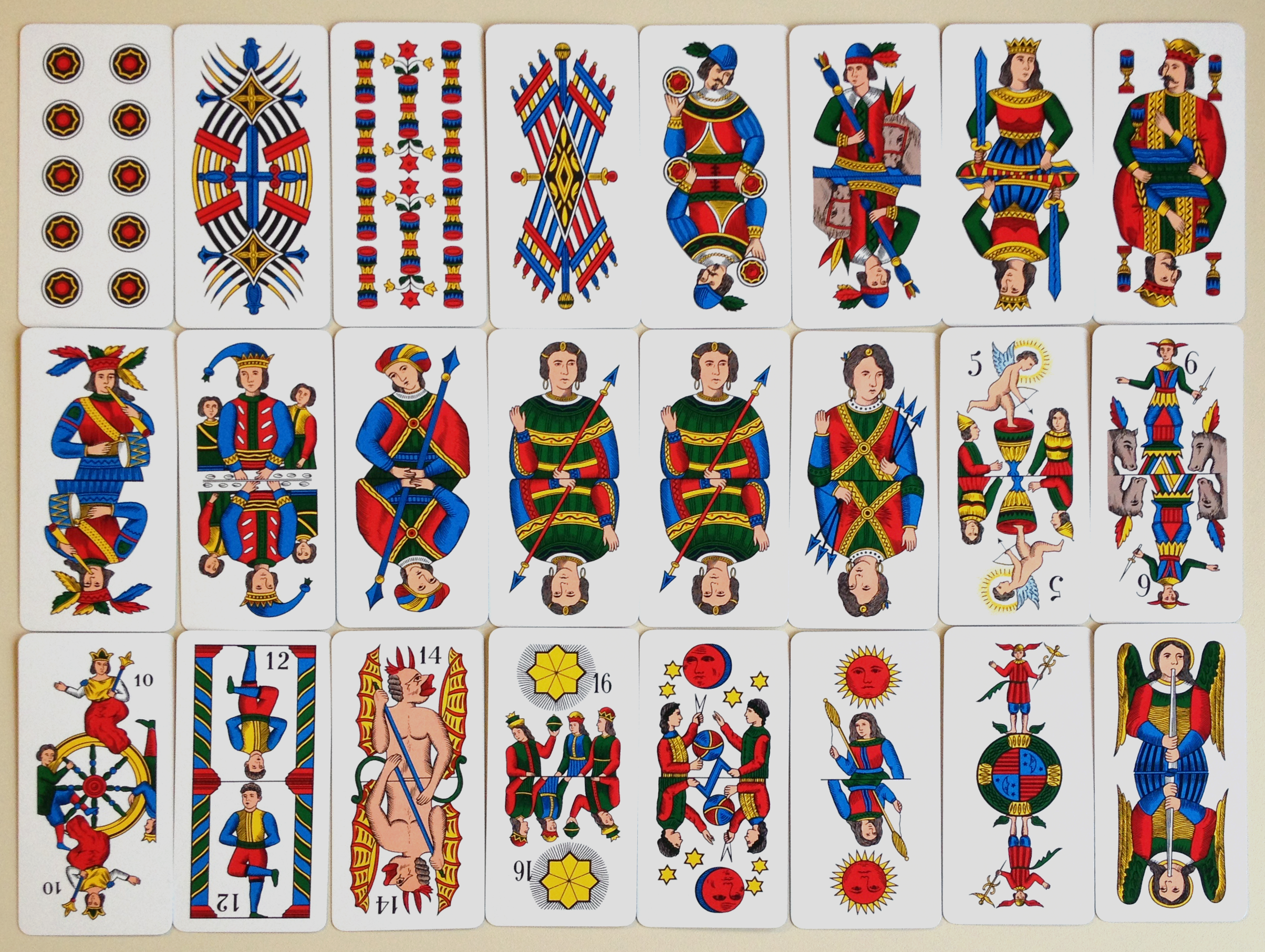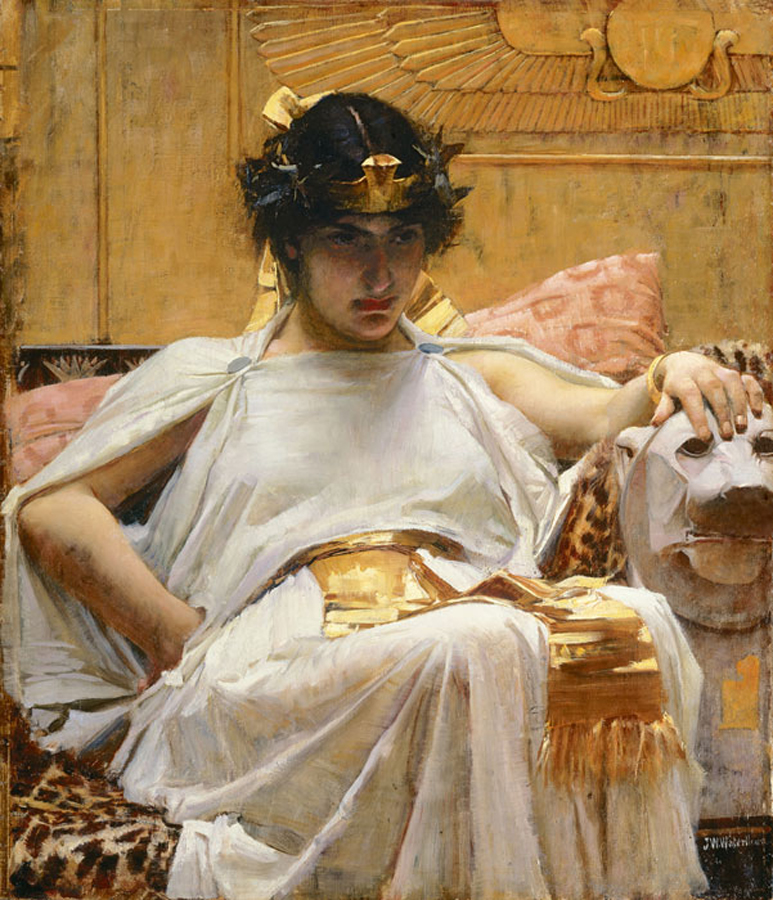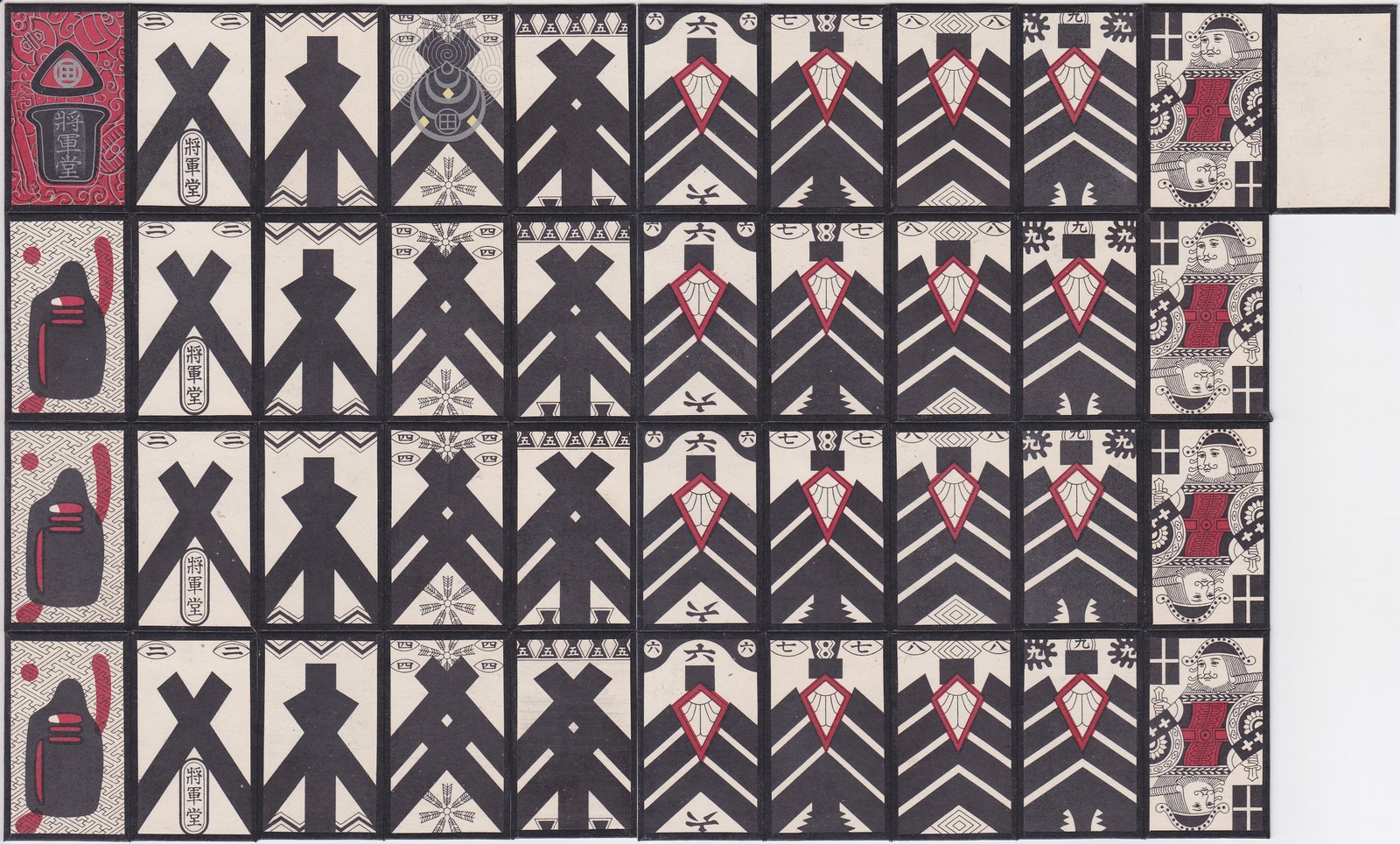|
Triumph (card Game)
Triomphe (French for triumph), once known as French ruff, is a card game dating from the late 15th century. It most likely originated in France or Spain (as triunfo) and later spread to the rest of Europe. When the game arrived in Italy, it shared a similar name with the pre-existing game and deck known as '' trionfi''; probably resulting in the latter becoming renamed as ''Tarocchi'' (tarot). While trionfi has a fifth suit that acts as permanent trumps, triomphe randomly selects one of the existing four suits as trumps. Another common feature of this game is the robbing of the stock. Triomphe became so popular that during the 16th century the earlier game of trionfi was gradually renamed tarocchi, tarot, or tarock. This game is the origin of the English word "trump" and is the ancestor of many trick-taking games like Euchre (via Écarté) and Whist (via Ruff and Honours). The earliest known description of Triomphe was of a point-trick game, perhaps one of the earliest of its type; ... [...More Info...] [...Related Items...] OR: [Wikipedia] [Google] [Baidu] |
Trick-taking
A trick-taking game is a card game, card- or tile-based game in which play of a ''Hand (card games), hand'' centers on a series of finite rounds or units of play, called ''tricks'', which are each evaluated to determine a winner or ''taker'' of that trick. The object of such games then may be closely tied to the number of tricks taken, as in plain-trick games such as contract bridge, whist, and Spades (card game), spades, or to the value of the cards contained in taken tricks, as in point-trick games such as pinochle, the Tarot card games, tarot family, briscola, and most evasion games like Hearts (card game), hearts. Trick-and-draw games are trick-taking games in which the players can fill up their hands after each trick. In most variants, players are free to play any card into a trick in the first phase of the game, but must ''follow suit'' as soon as the stock is depleted. Trick-avoidance games like reversis or Polignac (card game), polignac are those in which the aim is to a ... [...More Info...] [...Related Items...] OR: [Wikipedia] [Google] [Baidu] |
Tarot Card Games
Tarot games are card games played with tarot packs designed for card play and which have a permanent trump suit alongside the usual four card suits. The games and packs which English-speakers call by the French name tarot are called tarocchi in the original Italian, Tarock in German and similar words in other languages. Tarot cards were invented in northern Italy around 1420 for the purpose of playing cards. With their appearance came the first of the two great innovations in trick-taking games since they arrived in Europe: the concept of trumps. At around the same time or slightly earlier, a similar concept arose in the game of Karnöffel. In this south German game played with an ordinary pack, some cards of the given suit had full trump powers, others were partial trumps and the 7s had a special role. These features are retained in games of the Karnöffel family to the present, but are never seen in tarot games. Suits with these variable powers are called chosen or selec ... [...More Info...] [...Related Items...] OR: [Wikipedia] [Google] [Baidu] |
Huguenot
The Huguenots ( , ; ) are a Religious denomination, religious group of French people, French Protestants who held to the Reformed (Calvinist) tradition of Protestantism. The term, which may be derived from the name of a Swiss political leader, the Genevan burgomaster Besançon Hugues, was in common use by the mid-16th century. ''Huguenot'' was frequently used in reference to those of the Reformed Church of France from the time of the Protestant Reformation. By contrast, the Protestant populations of eastern France, in Alsace, Moselle (department), Moselle, and Montbéliard, were mainly Lutheranism, Lutherans. In his ''Encyclopedia of Protestantism'', Hans Hillerbrand wrote that on the eve of the St. Bartholomew's Day massacre in 1572, the Huguenot community made up as much as 10% of the French population. By 1600, it had declined to 7–8%, and was reduced further late in the century after the return of persecution under Louis XIV, who instituted the ''dragonnades'' to forcibly ... [...More Info...] [...Related Items...] OR: [Wikipedia] [Google] [Baidu] |
Project Gutenberg
Project Gutenberg (PG) is a volunteer effort to digitize and archive cultural works, as well as to "encourage the creation and distribution of eBooks." It was founded in 1971 by American writer Michael S. Hart and is the oldest digital library. Most of the items in its collection are the full texts of books or individual stories in the public domain. All files can be accessed for free under an open format layout, available on almost any computer. , Project Gutenberg had reached over 75,999 items in its collection of free eBooks. The releases are available in plain text as well as other formats, such as HTML, PDF, EPUB, MOBI, and Plucker wherever possible. Most releases are in the English language, but many non-English works are also available. There are multiple affiliated projects that provide additional content, including region- and language-specific works. Project Gutenberg is closely affiliated with Distributed Proofreaders, an Internet-based community for proofr ... [...More Info...] [...Related Items...] OR: [Wikipedia] [Google] [Baidu] |
Antony And Cleopatra
''Antony and Cleopatra'' is a tragedy by William Shakespeare. The play was first performed around 1607, by the King's Men at either the Blackfriars Theatre or the Globe Theatre. Its first appearance in print was in the First Folio published in 1623, under the title ''The Tragedie of Anthonie, and Cleopatra''. The plot is based on Thomas North's 1579 English translation of Plutarch's '' Lives'' (in Ancient Greek) and follows the relationship between Cleopatra and Mark Antony from the time of the Sicilian revolt to Cleopatra's suicide during the War of Actium. The main antagonist is Octavius Caesar, one of Antony's fellow triumvirs of the Second Triumvirate and the first emperor of the Roman Empire. The tragedy is mainly set in the Roman Republic and Ptolemaic Egypt and is characterized by swift shifts in geographical location and linguistic register as it alternates between sensual, imaginative Alexandria and a more pragmatic, austere Rome. Many consider Shakespeare's ... [...More Info...] [...Related Items...] OR: [Wikipedia] [Google] [Baidu] |
William Shakespeare
William Shakespeare ( 23 April 1564 – 23 April 1616) was an English playwright, poet and actor. He is widely regarded as the greatest writer in the English language and the world's pre-eminent dramatist. He is often called England's national poet and the "Bard of River Avon, Warwickshire, Avon" or simply "the Bard". His extant works, including William Shakespeare's collaborations, collaborations, consist of some Shakespeare's plays, 39 plays, Shakespeare's sonnets, 154 sonnets, three long narrative poems and a few other verses, some of uncertain authorship. His plays List of translations of works by William Shakespeare, have been translated into every major modern language, living language and are performed more often than those of any other playwright. Shakespeare remains arguably the most influential writer in the English language, and his works continue to be studied and reinterpreted. Shakespeare was born and raised in Stratford-upon-Avon, Warwickshire. At the age of 18 ... [...More Info...] [...Related Items...] OR: [Wikipedia] [Google] [Baidu] |
Hugh Latimer
Hugh Latimer ( – 16 October 1555) was a Fellow of Clare College, Cambridge, and Bishop of Worcester during the Reformation, and later Church of England chaplain to King Edward VI. In 1555 under the Catholic Queen Mary I he was burned at the stake, becoming one of the three Oxford Martyrs of Anglicanism. Life Latimer was born into a family of farmers in Thurcaston, Leicestershire. His birthdate is unknown. Contemporary biographers including John Foxe placed the date somewhere between 1480 and 1494. He later recalled that "my father...kept me to schole" and he started his studies in Latin grammar at the age of four, but not much else is known of his childhood. He attended the University of Cambridge from the age of 14, where according to the '' Alumni Cantabrigienses'' he was a pupil of John Watson and probably a scholar of Peterhouse. He was elected a fellow of Clare College on 2 February 1510, and in either that or the following year was awarded his Bachelor of Arts degr ... [...More Info...] [...Related Items...] OR: [Wikipedia] [Google] [Baidu] |
Follow Suit
A trick-taking game is a card- or tile-based game in which play of a ''hand'' centers on a series of finite rounds or units of play, called ''tricks'', which are each evaluated to determine a winner or ''taker'' of that trick. The object of such games then may be closely tied to the number of tricks taken, as in plain-trick games such as contract bridge, whist, and spades, or to the value of the cards contained in taken tricks, as in point-trick games such as pinochle, the tarot family, briscola, and most evasion games like hearts. Trick-and-draw games are trick-taking games in which the players can fill up their hands after each trick. In most variants, players are free to play any card into a trick in the first phase of the game, but must ''follow suit'' as soon as the stock is depleted. Trick-avoidance games like reversis or polignac are those in which the aim is to avoid taking some or all tricks. The domino game Texas 42 is an example of a trick-taking game that is not ... [...More Info...] [...Related Items...] OR: [Wikipedia] [Google] [Baidu] |
Face Card
In a deck of playing cards, the term face card (US) or court card (British and US), and sometimes royalty, is generally used to describe a card that depicts a person as opposed to the pip cards. In a standard 52-card pack of the English pattern, these cards are the King (playing card), King, Queen (playing card), Queen and Jack (playing card), Jack. The term picture card is also common, but that term sometimes includes the Aces. After the American innovation of corner-indices, the idea of "pictured" cards from tarot trumps was used to replace all 52 cards from the standard deck with pictures, art, or photography in some souvenir packs featuring a wide variety of subjects (animals, scenery, cartoons, pin-ups, vehicles, etc.) that may garner interest with collectors. In the standard packs of non-English speaking regions, the face or court cards may be different. For example, in Italian-suited cards, Italian- and Spanish-suited packs there is a Knight (playing card), Knight or Ca ... [...More Info...] [...Related Items...] OR: [Wikipedia] [Google] [Baidu] |
Ganjifa
Ganjifa, Ganjapa or Gânjaphâ, is a card game and type of playing cards that are most associated with Persia and India. After Ganjifa cards fell out of use in Iran before the twentieth century, India became the last country to produce them.At the start of the 21st Century production in India was still ongoing in the town of Sawantvadi in the west, and Odisha in the east for example. See Abram (2003: 53) and Crestin-Billet (2002: 189). The form prevalent in Odisha is Ganjapa. Description Ganjifa cards are circular or rectangular, and traditionally hand-painted by artisans. The game became popular at the Mughal Empire, Mughal court, and lavish sets were made, from materials such as precious stone-inlaid ivory or tortoise shell (''darbar kalam''). The game later spread to the general public, whereupon cheaper sets (''bazâr kalam'') would be made from materials such as wood, palm tree, palm leaf, stiffened cloth or pasteboard. Typically Ganjifa cards have coloured backgrounds, with ... [...More Info...] [...Related Items...] OR: [Wikipedia] [Google] [Baidu] |
Unsun Karuta
are Japanese playing cards. Playing cards were introduced to Japan by Portuguese traders during the mid-16th century. These early decks were used for trick-taking games. The earliest indigenous ''karuta'' was invented in the town of Miike in Chikugo Province at around the end of the 16th century. The Miike karuta Memorial Hall located in Ōmuta, Fukuoka, is the only municipal museum in Japan dedicated specifically to the history of ''karuta''. ''Karuta'' packs are classified into two groups, those that are descended from Portuguese-suited playing cards and those from ''e-awase''. ''E-awase'' originally derived from ''kai-awase'', which was played with shells but were converted to card format during the early 17th century. The basic idea of any ''e-awase karuta'' game is to be able to quickly determine which card out of an array of cards is required and then to grab the card before it is grabbed by an opponent. It is often played by children at elementary school and junior high ... [...More Info...] [...Related Items...] OR: [Wikipedia] [Google] [Baidu] |
Tổ Tôm
''Tổ tôm'' or Tụ tam bài (chữ Hán: 聚三牌, chữ Nôm: 祖𩵽) is a draw-and-discard card game played in Vietnam, usually by men. The game is often played at festivals. It is similar to the Chinese game of Khanhoo. Literally, ''tổ-tôm'' means ‘nest of shrimps’; however, when written in Sino-Vietnamese characters (Chữ Nôm) it is read ''tụ tam (bài)'' (Chinese 聚 三 牌 ''ju san pai''), ‘gathering three cards’, namely the three suits of Văn, Sách, and Vạn of the deck of cards. During holidays and Tết, tổ tôm was often played by men and the elderly because it has some quite difficult rules and many variations, so young uneducated people and women in the past rarely played it. Tổ tôm is not as popular and common as tam cúc. History and origin The origin of tổ tôm is still unclear, but by the 19th century in Vietnam, this card game was very popular, especially among the upper class who considered it an elegant game that require ... [...More Info...] [...Related Items...] OR: [Wikipedia] [Google] [Baidu] |







